Physical Address
304 North Cardinal St.
Dorchester Center, MA 02124
Physical Address
304 North Cardinal St.
Dorchester Center, MA 02124
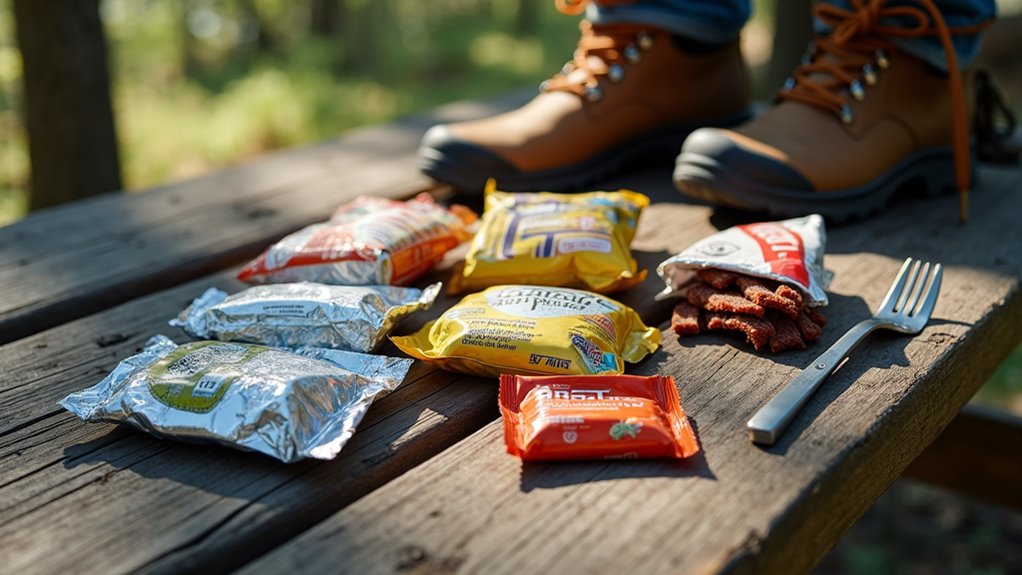
Fuel your multi-day adventures with budget-friendly, lightweight backpacking meals that prevent energy crashes when you need stamina most.
Did you know that on a typical backpacking trip, you’ll burn between 3,000-4,500 calories per day, yet most hikers only pack enough food for 2,500 calories? This caloric deficit can leave you feeling sluggish, irritable, and unable to enjoy those stunning summit views you’ve worked so hard to reach. The key isn’t just packing more food—it’s choosing the right combinations of lightweight, nutrient-dense options that’ll keep your energy steady without breaking your budget or your back.
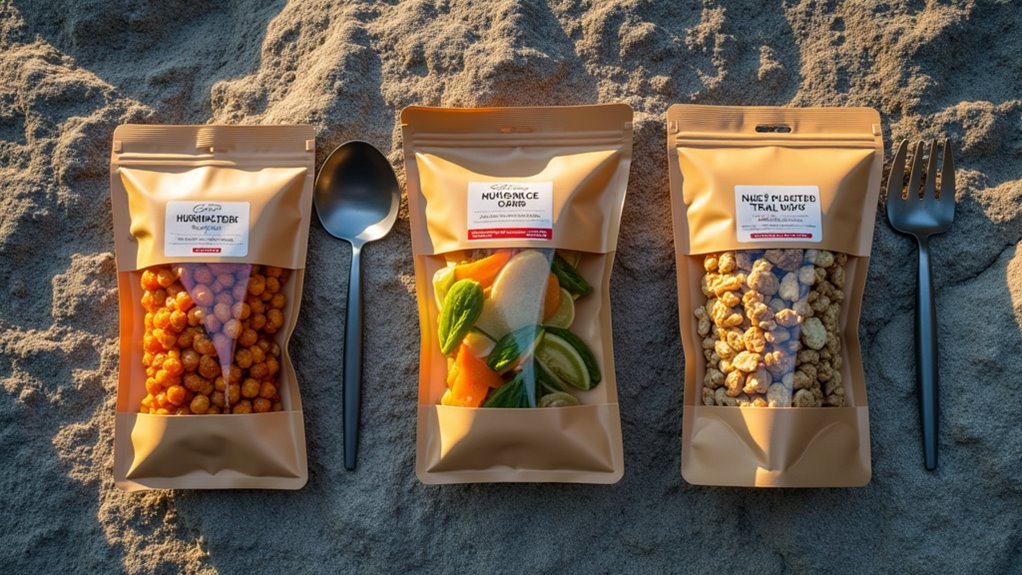
When you’re carrying everything on your back for days at a time, every calorie needs to count toward keeping you energized and healthy on the trail. You’ll need roughly 2,500-4,500 calories daily depending on your body weight, pack weight, and terrain difficulty.
Focus on macronutrient balance: 45-65% carbohydrates for quick energy, 20-35% fats for sustained fuel, and 10-35% protein for muscle recovery. Carbs should dominate breakfast and lunch, while fats work best for dinner when you’re settling down.
Don’t forget micronutrients – pack foods rich in sodium, potassium, and magnesium to replace what you’ll lose through sweat. Dehydration kills performance faster than hunger, so prioritize electrolyte balance alongside calorie density when selecting your trail foods. Just like hurricane preparation requires careful planning of essential supplies, organizing your backpacking nutrition demands the same level of strategic forethought to ensure you’re ready for whatever challenges the trail presents.
Since every ounce matters when you’re miles from the nearest grocery store, you’ll want foods that deliver maximum calories with minimal weight. Nuts and seeds top the list—almonds, walnuts, and sunflower seeds pack 500+ calories per 100 grams.
Dried fruits like dates and figs provide quick energy and natural sugars your body craves on the trail.
Nut butters in squeeze packets offer concentrated protein and healthy fats without messy jars. Hard cheeses like cheddar won’t spoil quickly and deliver satisfying calories. Olive oil adds instant calories to any meal—just one tablespoon contains 120 calories.
Don’t overlook chocolate, especially dark varieties. It’s calorie-dense, boosts morale, and won’t break your budget when bought in bulk.

While fresh ingredients taste great at home, they’ll weigh you down and spoil quickly on multi-day hikes. Dehydrated and freeze-dried meals solve both problems by removing moisture that adds weight and causes spoilage.
You’ll find two main types: dehydrated foods are cheaper but take longer to rehydrate and have chewier textures. Freeze-dried options cost more but rehydrate faster with better taste and texture.
Popular brands like Mountain House and Backpacker’s Pantry offer complete meals, but you can save money by making your own. Dehydrate cooked rice, pasta, vegetables, and lean meats at home using a food dehydrator or low oven setting.
Store everything in airtight containers or vacuum-sealed bags. Most meals just need boiling water and 10-15 minutes to become edible again.
These lightweight meal solutions are particularly valuable for extreme adventures like glacier climbing, where every ounce matters and resupply opportunities are non-existent.
Although dehydrated meals handle your main nutrition needs, you’ll burn through calories fast on the trail and need portable snacks that pack serious energy. Trail mix remains king – combine nuts, dried fruit, and chocolate for fat, sugar, and protein. You can’t beat homemade versions for cost savings.
Energy bars work great, but they’re pricey. Make your own with oats, peanut butter, honey, and add-ins like coconut or seeds. Jerky provides lean protein that won’t spoil. Nut butters in squeeze packets offer concentrated calories and taste amazing on crackers or tortillas.
Don’t overlook simple options: dried banana chips, cheese sticks, or hard-boiled eggs for day one. Pack snacks in daily portions to avoid overeating your supply early. If you’re planning to combine your backpacking trip with rock climbing activities, focus on easily digestible, high-energy foods that won’t weigh you down during technical ascents.
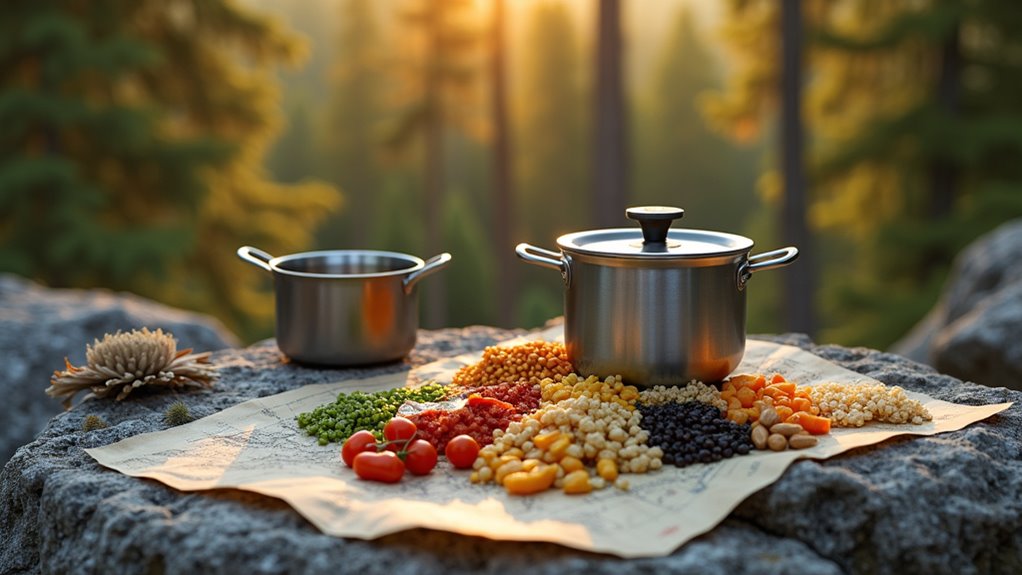
Beyond simple snacks, you can create satisfying trail meals with shelf-stable ingredients that won’t weigh down your pack or break your budget. Stock up on versatile basics like instant rice, couscous, and pasta that cook quickly with minimal fuel.
Create delicious, budget-friendly trail meals using lightweight, shelf-stable ingredients that cook fast and won’t burden your backpack.
Canned beans, tuna, and chicken provide protein without refrigeration. Dried vegetables, nuts, and seeds add texture and nutrients to any dish.
Spice packets and bouillon cubes transform bland ingredients into flavorful meals. Olive oil packets, hot sauce, and dried herbs travel well and make everything taste better.
Don’t overlook tortillas—they’re lightweight, last for days, and work for wraps, quesadillas, or makeshift pizza bases. Powdered cheese, dried fruit, and nuts turn basic grains into hearty, satisfying dinners that’ll fuel your adventures.
These camping secrets separate experienced backpackers from novices who struggle with bland, unsatisfying trail food.
Since water weighs over two pounds per liter, you’ll need to balance carrying enough for safety with keeping your pack manageable. Plan for at least two liters daily, more in hot weather or high altitudes.
Research water sources along your route using maps and apps like Guthook or FarOut.
Invest in reliable purification—water filters, purification tablets, or UV sterilizers work well. Carry backup purification methods since equipment fails.
Electrolyte powder or tablets cost less than sports drinks and weigh almost nothing. Add them to your water bottle to replace lost minerals.
Start hydrating before you feel thirsty, and monitor your urine color—pale yellow indicates proper hydration.
Drink small amounts frequently rather than chugging large quantities.
Consider a hydration bladder for easy access while hiking.
Remember that dehydration prevention requires consistent attention throughout your trip, as the wilderness environment can quickly deplete your body’s water reserves.
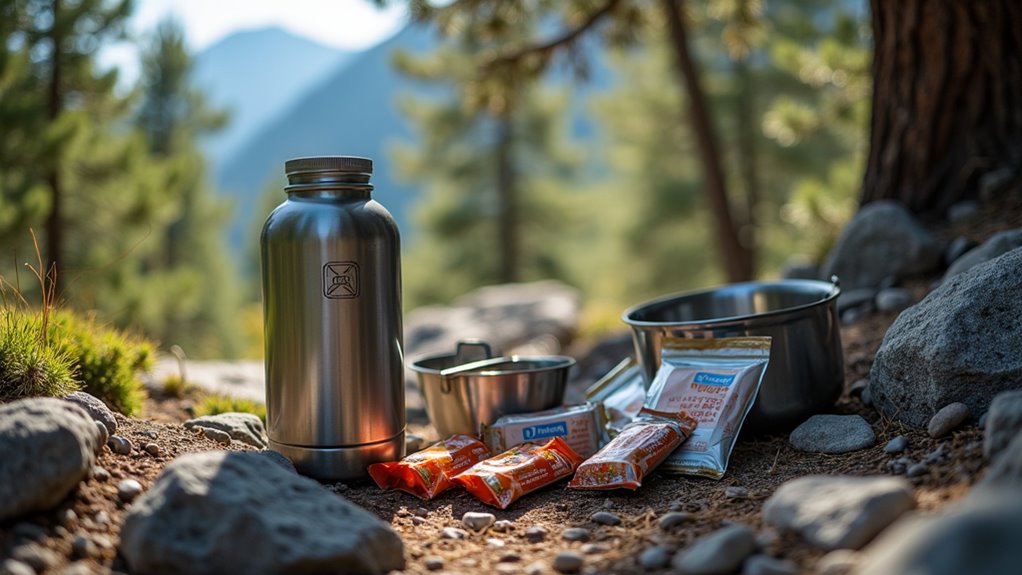
While proper hydration keeps you healthy on the trail, protecting your food from wildlife keeps you safe and preserves fragile ecosystems. Bears, raccoons, and rodents can destroy your gear and create dangerous encounters when they associate humans with food sources.
You’ll need reliable storage methods that won’t break your budget:
Proper food storage isn’t optional—it’s essential backcountry ethics that protects both you and wildlife. Following established camping etiquette helps ensure a respectful outdoor experience for all visitors and minimizes your impact on the wilderness environment.
When you’re planning multi-day adventures, calculating your caloric needs becomes essential for maintaining energy without carrying excess weight. Plan for 2,500-4,500 calories daily depending on your body weight, pack weight, and terrain difficulty.
Create a simple meal rotation using three breakfast, lunch, and dinner options to prevent food fatigue while streamlining your shopping list. Pre-portion meals at home using ziplock bags or lightweight containers – this saves money versus buying individual servings and ensures accurate portions.
Track your consumption on shorter trips to refine your calculations. Pack 10% extra food as buffer, but don’t overpack. Weight matters when you’re carrying everything.
Focus on calorie-dense foods like nuts, dried fruits, and dehydrated meals that provide maximum nutrition per ounce.
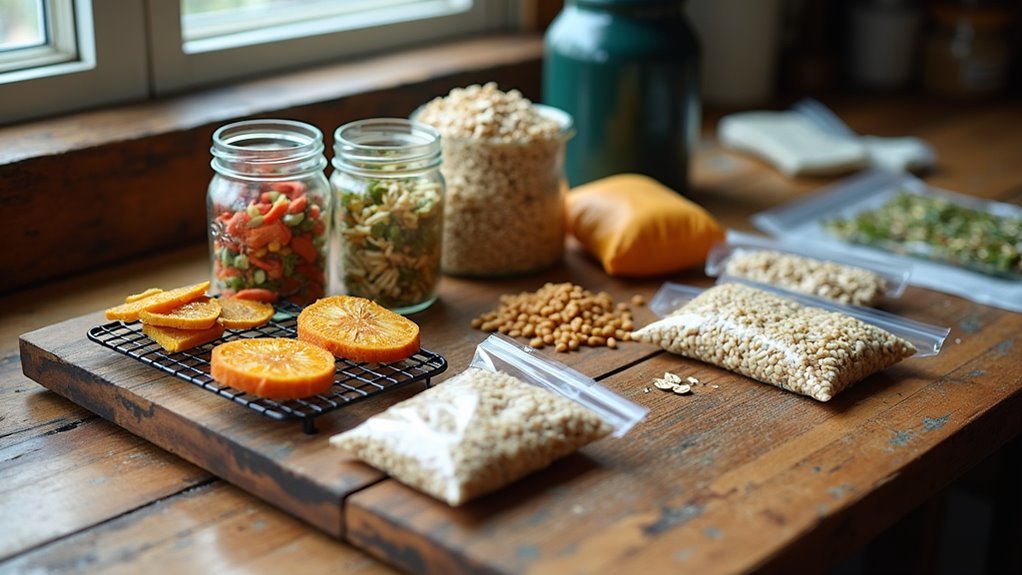
Although commercial backpacking meals offer convenience, they’ll quickly drain your wallet at $8-15 per serving. You can slash your food costs by 70% with smart DIY alternatives that taste better and provide more nutrition.
Your grocery store becomes your best resource for lightweight, shelf-stable options:
You’ll save hundreds on week-long trips while enjoying customized flavors that match your preferences perfectly. When preparing these budget-friendly meals, practice low impact camping principles by choosing minimal packaging and reusable containers to reduce waste on the trail.
You’ve now got the blueprint to fuel your trail adventures without emptying your wallet. Think of yourself as a culinary architect, building meals that’ll carry you through miles of wilderness. Your backpack becomes a portable pantry, packed with lightweight powerhouses that won’t weigh you down. Remember, smart food planning isn’t just about surviving—it’s about thriving on the trail while keeping your budget and pack weight in check. Happy hiking!